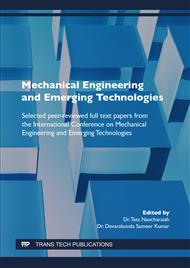p.35
p.41
p.51
p.61
p.69
p.75
p.81
p.93
p.101
Comparative Study on the Biodegradation Behavior of Pure Mg in NaCl Solution and Simulated Body Fluids
Abstract:
Developing Mg based implants for temporary applications based on their biodegradation in the physiological environment is a potential research area in the biomedical engineering. Assessing the bio-corrosion in simulated conditions helps to reduce the complexity of research studies associated with in-vivo experiments and can be used to assess the true behavior of the Mg implant in artificial solutions. On the other hand, assessing the corrosion behavior by using 3.5% NaCl solution is a standard ASTM protocol widely used in the industries. Hence, in the present work, degradation of pure Mg due to bio-corrosion in two different solutions i.e simulated body fluids (SBF) and 3.5% NaCl solution has been investigated. From the results, the weight loss measurements indicated higher degradation during the initial 24 h in SBF solution. However, with the increased immersion time to 72 h, due to the deposition of mineral phases from SBF as confirmed from the electron microscopy and X-Ray diffraction study, the degradation was observed as decreased in SBF compared with NaCl solution. Hence, the results demonstrate that the evaluation of degradation behavior of Mg based materials in simulated physiological environments is appropriate compared with the standard NaCl environment.
Info:
Periodical:
Pages:
69-73
Citation:
Online since:
September 2022
Keywords:
Price:
Сopyright:
© 2022 Trans Tech Publications Ltd. All Rights Reserved
Share:
Citation:


